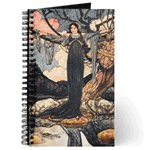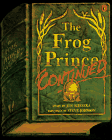| Introduction | Annotated Tales | eBooks | Bookstore | Illustration Gallery | Discussion Board | Blog |
 |
|
Best of the Web Frog King Tales collected by D. L. Ashliman Married to Magic: Animal Brides and Bridegrooms in Folklore and Fantasy by Terri Windling
|
According to Stith Thompson, The Frog King dates back to thirteenth century Germany where a Latin version of the tale was written. It later appeared in Scotland in the sixteenth century. The Scottish version is often called "The Well of the World's End" and it appears in a table of contents for The Complaynt of Scotland in 1549. A recorded English version of the tale was written by Robert Chambers in 1842. Chambers had learned it from Charles Kirkpatrick Sharpe who had heard it in turn from his nurse as a child. This version was really only a fragment however. Halliwell later embellished the tale in his Popular Rhymes and Nursery Tales (1849). In 1890, Joseph Jacobs patched another version of the tale together for his English Fairy Tales collection (Opies 183). A copy of Jacobs' version is available on this site on the Tales Similar to The Frog King page. Still, the Grimms were the first to write down a lasting version of the tale as it is known today. Despite its early roots in literary form, the tale has been well-known by storytellers in almost every European country, stretching from Scotland to Germany to Russia. The tale has not appeared on any other continent however (Thompson 101). Tales of enchanted frogs, however, appear in many cultures including China, Sri Lanka and Korea. The Opies support this statement by presenting the claims of Sir Walter Scott and John Leyden who remembered the tale from their English childhoods after reading the version presented by the Grimms. Thompson speculates that the tale has gained such great popularity because it is traditionally the first tale presented in the Grimms' collection. However, the tale's theme of an enchanted bridegroom is not very different from other popular tales, most notably Beauty and the Beast. The story is known as both the Frog Prince and the Frog King in various cultures with a few variations in the story. D. L. Ashliman explains on his Frog King page that:
Taylor is also responsible for the title change from "The Frog King" to "The Frog Prince." He translated two tales from the Grimms, one titled "Frog King" and one titled "Frog Prince." The "Frog Prince" was omitted from later editions of Grimms, but Taylor combined the two stories and used "Frog Prince" for his title. |
|
| ©Heidi
Anne Heiner, SurLaLune Fairy Tales E-mail: heidi@surlalunefairytales.com Page created 2/1999; Last updated 6/29/07 www.surlalunefairytales.com |





